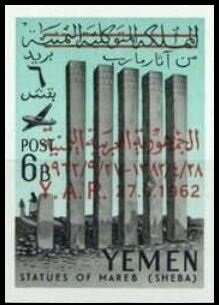Stamp: Square sandstone pillars (Ilumgul Temple) - overprinted (Yemen, Arab Republic 1963)
Square sandstone pillars (Ilumgul Temple) - overprinted (Yemen, Arab Republic 1963)
01 January (Yemen, Arab Republic ) within release Sabean finds from Marib goes into circulation Stamp Square sandstone pillars (Ilumgul Temple) - overprinted face value 6 Yemeni buqsha
| Stamp Square sandstone pillars (Ilumgul Temple) - overprinted in catalogues | |
|---|---|
| Michel: | Mi: YE-AR 259B |
Stamp is square format.
Red overprint also in Arabic: Y.A.R. 27.9.1962Also in the issue Sabean finds from Marib:
- Stamp - Military parts of the Marib Dam - overprinted face value 16;
- Stamp - Bronze statue of the emperor Dhamar Ali - overprinted face value 8;
- Stamp - Torso of a riding boy - overprinted face value 10;
- Stamp - Bull's head, relief detail (Ilumgul Temple)r - overprinted face value 2;
- Stamp - Head of an emperor, Bronze - overprinted face value 4;
- Stamp - Death mask, Alabaster - overprinted face value 1;
- Stamp - Square sandstone pillars (Ilumgul Temple) - overprinted face value 6;
- Stamp - Bronze statue of the emperor Dhamar Ali - overprinted face value 8;
- Stamp - Bull's head, relief detail (Ilumgul Temple)r - overprinted face value 1;
- Stamp - Death mask, Alabaster - overprinted face value 1;
- Stamp - Head of an emperor, Bronze - overprinted face value 4;
- Stamp - Ilumgul temple - overprinted face value 12;
- Stamp - Military parts of the Marib Dam - overprinted face value 16;
- Stamp - Relief piece of a woman, Alabaster - overprinted face value 1;
- Stamp - Relief piece of a woman, Alabaster - overprinted face value 1;
- Stamp - Relief piece with a winged monster, Alabaster - overprinted face value 20;
- Stamp - Relief piece with a winged monster, Alabaster - overprinted face value 20;
- Stamp - Square sandstone pillars (Ilumgul Temple) - overprinted face value 6;
- Stamp - Torso of a riding boy - overprinted face value 10;
Stamp Square sandstone pillars (Ilumgul Temple) - overprinted it reflects the thematic directions:
An aircraft (pl. aircraft) is a vehicle that is able to fly by gaining support from the air. It counters the force of gravity by using either static lift or the dynamic lift of an airfoil, or, in a few cases, direct downward thrust from its engines. Common examples of aircraft include airplanes, rotorcraft (including helicopters), airships (including blimps), gliders, paramotors, and hot air balloons.Part 1 (Definitions and Abbreviations) of Subchapter A of Chapter I of Title 14 of the U. S. Code of Federal Regulations states that aircraft "means a device that is used or intended to be used for flight in the air."
Aviation is the practical aspect or art of aeronautics, being the design, development, production, operation and use of aircraft, especially heavier than air aircraft. The word aviation was coined by French writer and former naval officer Gabriel La Landelle in 1863, from the verb avier (synonymous flying), itself derived from the Latin word avis ("bird") and the suffix -ation.
A temple (from the Latin word templum) is a building reserved for religious or spiritual rituals and activities such as prayer and sacrifice. It is typically used for such buildings belonging to all faiths where a more specific term such as church, mosque or synagogue is not generally used in English. These include Hinduism, Buddhism, and Jainism among religions with many modern followers, as well as other ancient religions such as Ancient Egyptian religion.



